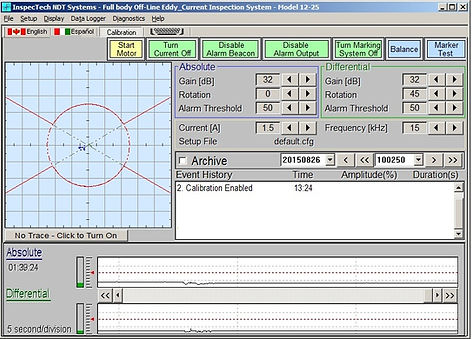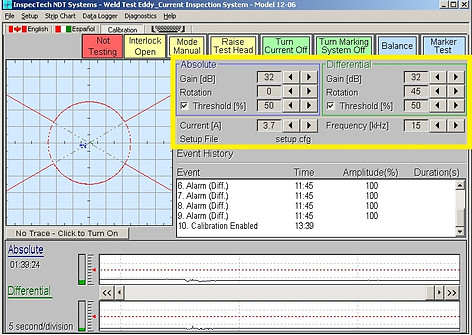Eddy Current
Full Body
Weld testing of ERW & pipe
Full body Eddy Current testing of tubular product is commonly an off-line (off the tube mill) process. It is very useful in cold draw operations to test the finished product before the ends are cropped. However, from time to time, the full body test is used as an on-line tool, mainly when small diameter (<25mm) tube is to be tested.
A full body eddy current test requires the tube to pass through an encircling coil. Size specific test coils are needed if several tube diameters are to be tested. If the test material is ferromagnetic a magnetic saturater is built into the test head with quick change pole pieces for the different product diameters.

Key Feature
Versions available for magnetic and non-magnetic materials.
Suitable for high speed testing.
Differential and absolute channels as standard.
Full impedance plane analysis as standard.
Defect marking system included as standard.
Complete Data Logging of all Test Parameters easily stored, retrieved, hard-copied or downloaded.
Instant recall of previously used setups.

The off-line (off the tube mill), version of the full body eddy current unit is normally supplied as a complete test stand including pinch rolls and drive mechanism. This complete unit can be supplied by InspecTech to the correct run height for insertion into a conveyor line. The on-line (on the tube mill), version uses just the test head mounted on the mill bed, with the mill providing the required steady throughput of the tube. In the on-line arrangements, rotators or sliders can be provided to move the test head out of the run line for easier set-up and calibration.
When ferromagnetic material is saturated for eddy current testing, strong residual magnetic fields can exist in the product after testing. Consult InspecTech for demagnetizing options.
Weld line
testing system
The InspecTech® Eddy Current System is a utility on-line non-destructive testing system for weld-line inspection of thin wall tubing and can be used on high speed mills. Eddy Current is a cost effective method of testing welded tube. In the case of magnetic materials, there is also the requirement to saturate the weld.
This means that the material to be tested must be magnetized to a high level, at which point it will behave under Eddy Current conditions in much the same way as any non-magnetic material. InspecTech’s Eddy Current Equipment is compact enough to fit on most mill beds, or can be floor mounted. Rotary stands are available to handle extremely large weld line skews.

Key Feature
Full Impedance plane display included as standard.
Differential and absolute detection modes included as standard.
User friendly and low initial cost.
Odometer and defect marking system included as standard.
Probes cover a wide range of Weld-Line Wander.
Complete Data Logging of all on-line Test Parameters easily stored, retrieved, hard-copied or downloaded.
Instant recall of previously used setups.

The standard system consists of the mechanical test head which is mounted on the mill, and a stand alone electronic package. The test head is available in large and small sizes. The small unit tests from 0.500” (12mm) to 3.500” (90mm) OD, and the large unit tests up to 6.625” (170mm) OD.
The Eddy Current application has a separate Data Logger software (supplied pre-loaded) that allows all relevant information from each session to be stored and downloaded for printing or storage at another location. The information stored by the Data Logger includes operator ID, calibration data, alarm settings, and information relating to total production and alarm locations (distances in metres or feet along the
inspected product). The InspecTech Eddy Current Test System is particularly suitable for the following:
-
High-speed mill operations, small defects can be detected at high throughput
-
Detecting spherical, circular and pinhole defects


